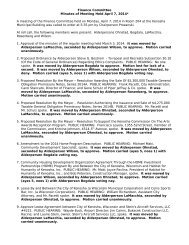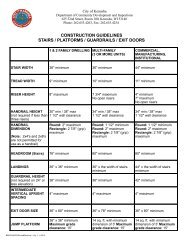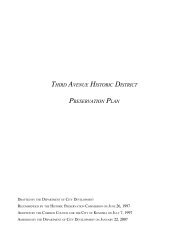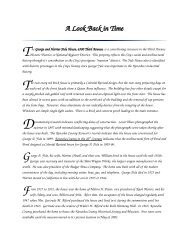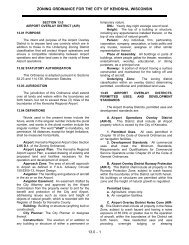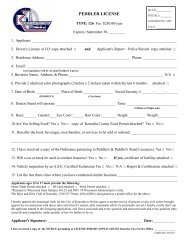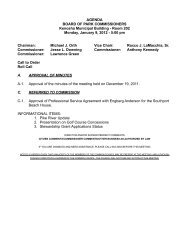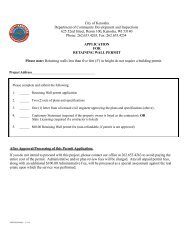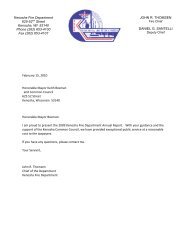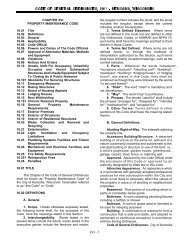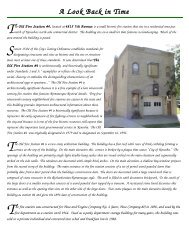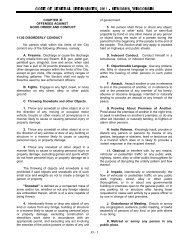The Isermann House - City of Kenosha, Wisconsin
The Isermann House - City of Kenosha, Wisconsin
The Isermann House - City of Kenosha, Wisconsin
You also want an ePaper? Increase the reach of your titles
YUMPU automatically turns print PDFs into web optimized ePapers that Google loves.
A Look Back in Time<br />
<strong>The</strong> Frank and Jane <strong>Isermann</strong> <strong>House</strong>, 6500 Seventh Avenue, was placed on the National Register <strong>of</strong><br />
Historic Places and the State Register <strong>of</strong> Historic Places on February 25, 2004. <strong>The</strong> property was<br />
designated an individual landmark by the Common Council on August 19, 1996 based on Standards 3 and 4 <strong>of</strong><br />
Section 15.04 <strong>of</strong> the <strong>City</strong>'s Zoning Ordinance stating its' architectural significance and notable work by the<br />
master builder.<br />
<strong>The</strong> Frank and Jane <strong>Isermann</strong> <strong>House</strong> is a twostory residence designed by Russell Barr Williamson in the<br />
Prairie Style. <strong>The</strong> building has a rectangular plan with a projecting onestory sun room ell at the<br />
southwest corner <strong>of</strong> the house. <strong>The</strong> house has a lowpitched hip ro<strong>of</strong> with wide, overhanging eaves. <strong>The</strong> walls<br />
<strong>of</strong> the building are faced with brown bricks and are decorated with shallow piers between the windows. A<br />
twostory shallow bay projects from the south wall <strong>of</strong> the house and is attached to the onestory sun room ell.<br />
<strong>The</strong> window openings consist <strong>of</strong> casements set into window bands. <strong>The</strong> upper story windows are smaller than<br />
those <strong>of</strong> the lower story and are set right under the ro<strong>of</strong> eaves. <strong>The</strong>se windows are also accented with a stone<br />
belt course and a stone lintel accents the windows <strong>of</strong> the first story main elevation. Projecting from the main<br />
elevation is a broken brick wall with a stucco ledge that holds the wall sections together.<br />
<strong>The</strong> house was built in 1923 for Frank <strong>Isermann</strong>, an executive with the <strong>Isermann</strong> Clothing Store. <strong>The</strong><br />
<strong>Isermann</strong> Clothing Store was established in 1892 and was a significant commercial business in<br />
downtown <strong>Kenosha</strong> for approximately 50 years. Frank <strong>Isermann</strong> served as Secretary for the firm. Frank and<br />
Jane <strong>Isermann</strong> lived in the home until the 1950s. Between the 1950s and 1980s, the house was occupied by<br />
Donald and Elsie <strong>Isermann</strong>, also associated with the <strong>Isermann</strong> Clothing Store.<br />
<strong>The</strong> Frank and Jane <strong>Isermann</strong> <strong>House</strong> is architecturally significant because it is a fine example <strong>of</strong> the<br />
Prairie Style <strong>of</strong> architecture and because it was designed by Russell Barr Williamson, a student <strong>of</strong> Frank<br />
Lloyd Wright, the leading architect <strong>of</strong> the style. <strong>The</strong> Prairie Style was developed by a group <strong>of</strong> progressive<br />
architects let by Frank Lloyd Wright, George Grant Elmslie, and George W. Maher in early twentieth century<br />
Chicago. <strong>The</strong> style emphasizes horizontal lines by using lowpitched rooms with wide, overhanging eaves,<br />
banded windows, emphatic belt courses, and natural building materials. This house is a fine example <strong>of</strong> the<br />
style because is has all the typical features. It is a classic example <strong>of</strong> the style and very reminiscent <strong>of</strong> the<br />
houses built by midwestern Prairie Style architects during the 1910s.
This Prairie Style <strong>House</strong> and the same style house next door at 6416 Seventh Avenue are worth riding by.<br />
Experience the classic lines, banded windows, and mature lawns for yourself. See firsthand why they<br />
are historically significant to the <strong>City</strong> <strong>of</strong> <strong>Kenosha</strong>.



